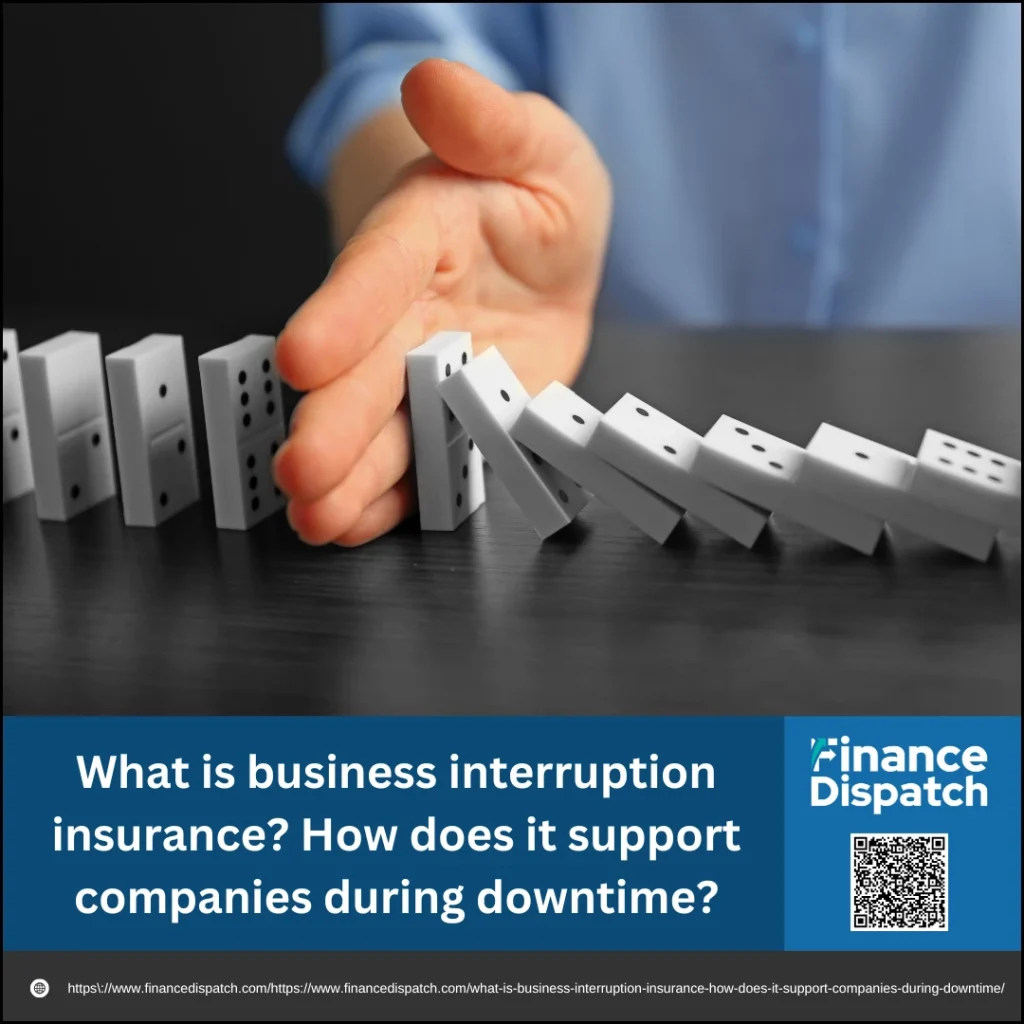Unexpected disruptions—like fires, natural disasters, or cyberattacks—can bring a thriving business to a standstill. While property insurance covers physical damages, it doesn’t address the financial losses that follow operational downtime. That’s where business interruption insurance steps in. This specialized coverage helps companies recover lost income, manage ongoing expenses, and maintain financial stability when they’re forced to pause operations. In this article, we’ll explore what business interruption insurance is and how it plays a crucial role in helping businesses survive and rebuild during periods of unexpected closure.
What is Business Interruption Insurance?
Business interruption insurance, also known as business income insurance, is a type of coverage that helps protect a company from financial losses when it is forced to temporarily shut down due to a covered event, such as a fire, storm, or other disaster. Unlike property insurance, which pays for physical damage to buildings or equipment, business interruption insurance focuses on the income a business loses during the downtime and the expenses that continue to accrue. This coverage can be included as part of a commercial property policy or added through an endorsement, and it plays a critical role in ensuring that businesses can maintain financial stability while they work to resume normal operations.
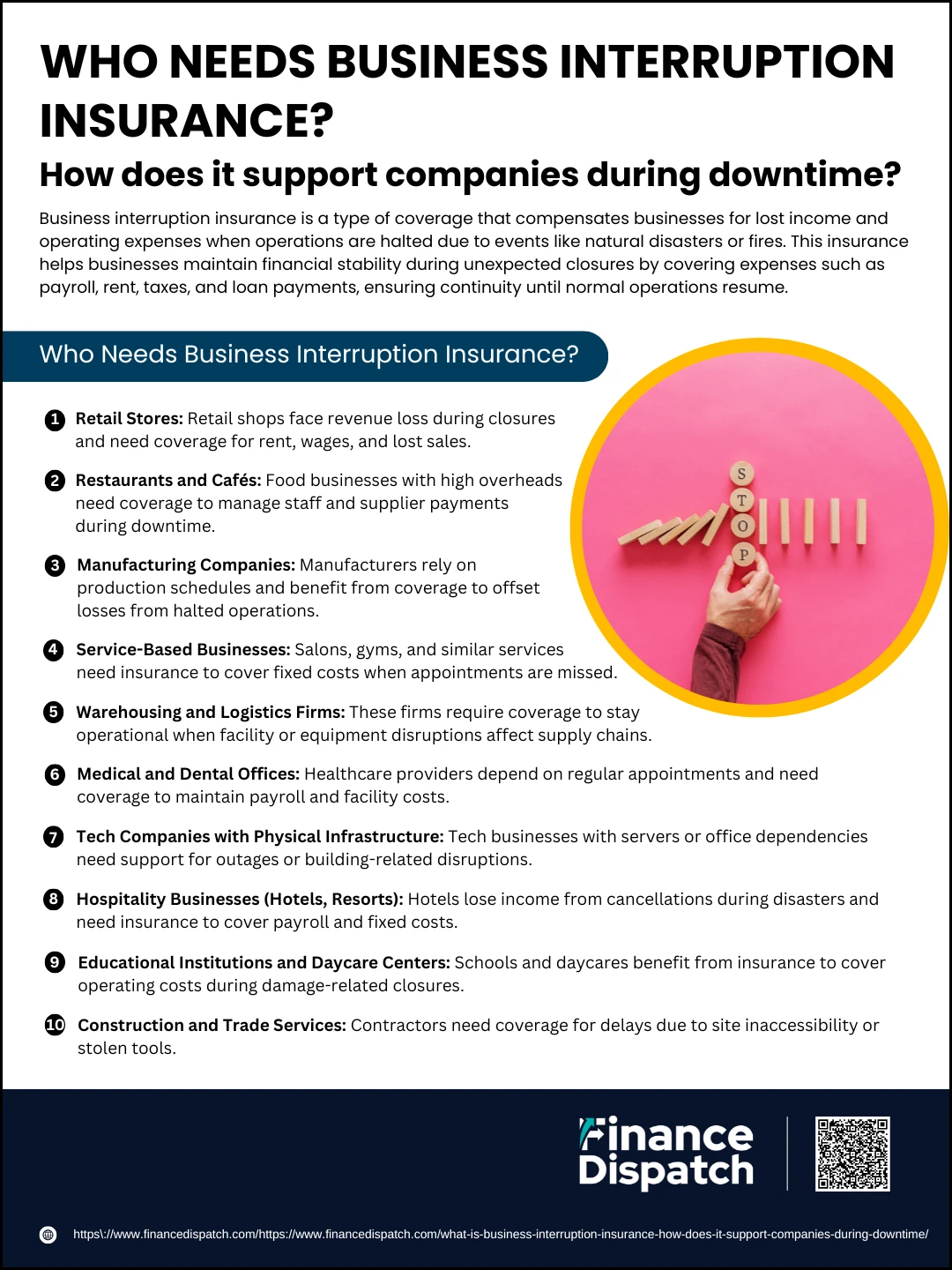 Who Needs Business Interruption Insurance?
Who Needs Business Interruption Insurance?
Not every disruption leads to permanent closure—but without financial protection, even a short interruption can put a business at serious risk. Business interruption insurance is designed to bridge that gap. It helps companies recover lost income, cover ongoing expenses, and resume operations without falling into debt. This coverage is especially vital for businesses that rely on daily operations, physical locations, or steady customer flow. If your revenue would stop the moment your doors close, this insurance could be the lifeline that keeps your business afloat during crises.
Here are the types of businesses that need business interruption insurance the most:
1. Retail Stores
Brick-and-mortar shops depend on regular customer traffic. A fire, storm, or burglary can shut down a store for days or weeks, causing a major hit to revenue. Business interruption insurance can cover lost sales, rent, and employee wages until the store reopens.
2. Restaurants and Cafés
With high overhead and slim margins, food businesses are especially vulnerable. A kitchen fire or water leak could halt operations, and without coverage, owners may struggle to pay staff or suppliers during the closure.
3. Manufacturing Companies
These operations rely on machinery, raw materials, and production schedules. If a facility is damaged or supply chain partners are affected, production stops—causing delays, lost contracts, and profit losses that interruption insurance can help offset.
4. Service-Based Businesses
Personal service providers like salons, fitness centers, or auto repair shops lose money with every missed appointment. Business interruption coverage ensures continued cash flow to meet fixed costs, even when no clients can be served.
5. Warehousing and Logistics Firms
These businesses serve as backbones to supply chains. Damage to a facility or equipment downtime can ripple across multiple partners. Interruption insurance helps pay for alternative solutions and keeps your operation viable.
6. Medical and Dental Offices
Healthcare providers must maintain regular appointments to remain financially healthy. If their offices are damaged or closed due to a covered event, business interruption insurance helps cover payroll and facility costs while they recover.
7. Tech Companies with Physical Infrastructure
While many tech businesses operate online, they often rely on server rooms, offices, or specialized equipment. Cyberattacks, power outages, or building issues can stall operations, and insurance helps maintain service continuity and team support.
8. Hospitality Businesses (Hotels, Resorts)
Lost bookings due to natural disasters or mandatory evacuations can be devastating—especially during peak season. Business interruption coverage helps cover payroll and fixed expenses until tourism returns.
9. Educational Institutions and Daycare Centers
Schools and daycare centers still face rent, insurance, and salary obligations even if closures occur due to damage or safety concerns. Interruption insurance helps bridge that financial gap.
10. Construction and Trade Services
These businesses often work on strict timelines. If their tools are stolen or job sites become inaccessible, projects are delayed and penalties or lost revenue follow. Interruption insurance can cover costs during these pauses.
Common Causes of Business Interruption
Unexpected events can halt business operations in an instant, leading to significant financial losses and operational challenges. Understanding the most common causes of business interruption can help companies prepare for potential risks and secure the right insurance coverage. These disruptions often arise from both natural and man-made sources, and without adequate protection, recovery can be slow and costly.
Here are some of the most common causes of business interruption:
1. Natural Disasters
Events like hurricanes, earthquakes, floods, and wildfires can damage physical property and make it impossible for a business to operate.
2. Fires and Explosions
Fires remain one of the leading causes of business closures. They can destroy buildings, inventory, and equipment, resulting in long recovery times.
3. Storm and Weather Events
Severe storms can cause structural damage, power outages, and access issues, especially for businesses dependent on customer foot traffic or logistics.
4. Equipment or Machinery Breakdown
Manufacturing and industrial businesses often face downtime when key machinery fails unexpectedly.
5. Cyber Attacks and Data Breaches
In today’s digital age, a single cyberattack can disrupt operations, compromise customer data, and shut down systems temporarily or permanently.
6. Utility Failures
Loss of electricity, water, or internet services—especially during peak hours—can render a business inoperable.
7. Supply Chain Disruptions
If a key supplier or distributor faces problems, it can halt production or delivery of goods, affecting sales and customer relationships.
8. Vandalism or Theft
Damage or loss due to break-ins can not only require repairs or replacements but also lead to temporary closures during investigations or rebuilding.
9. Government-Mandated Closures
Civil authority actions, such as roadblocks or curfews during emergencies, can force businesses to close even if their property is undamaged.
10. Pandemics and Health Crises
Though typically excluded from standard policies, events like COVID-19 have shown how health crises can cause widespread business closures.
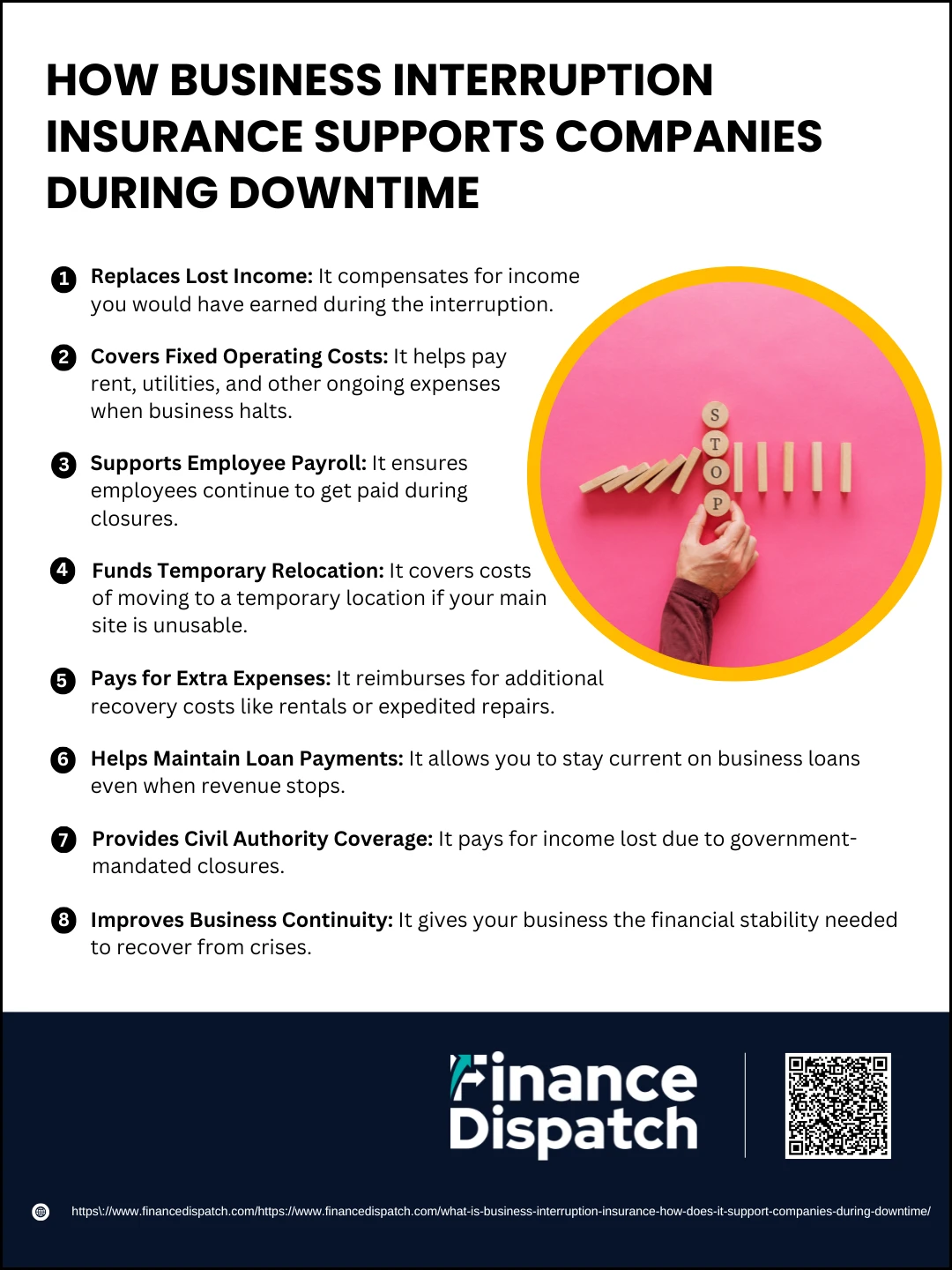 How Business Interruption Insurance Supports Companies During Downtime
How Business Interruption Insurance Supports Companies During Downtime
When your business experiences an unexpected disruption, it’s not just the physical damage that hurts—it’s the loss of income, strained cash flow, and mounting financial pressure that follow. Business interruption insurance is designed specifically to help you bridge that financial gap. While you work to repair, relocate, or recover, this coverage ensures you can still meet your financial obligations and retain the resources you need to get back on track. Whether it’s paying staff, covering rent, or managing unforeseen expenses, business interruption insurance provides a critical lifeline during uncertain times.
Here’s how business interruption insurance supports companies during downtime:
1. Replaces Lost Income
One of the main functions of this insurance is to reimburse the revenue your business would have earned if operations hadn’t been interrupted. This payout is typically calculated using past financial records and sales projections, allowing your business to maintain its income stream while closed.
2. Covers Fixed Operating Costs
Even when your doors are closed, the bills don’t stop. Business interruption insurance helps pay for ongoing fixed expenses like rent, utility bills, property taxes, and business insurance premiums so your financial obligations remain covered.
3. Supports Employee Payroll
Your employees are critical to your business, and losing them during a shutdown can make recovery even harder. This coverage allows you to continue paying wages and benefits during the interruption, helping retain key staff and maintain morale.
4. Funds Temporary Relocation
If your primary business location becomes unusable, the policy can cover the costs associated with relocating to a temporary site. This includes rent for the new space and moving costs, allowing you to resume operations sooner.
5. Pays for Extra Expenses
During recovery, you may need to rent temporary equipment, hire specialists, or speed up repairs to reduce downtime. Business interruption insurance can reimburse these extra but necessary expenses aimed at getting your business up and running faster.
6. Helps Maintain Loan Payments
If your business has existing loans or lease agreements, those payments remain due—even when revenue stops. This coverage helps you stay current on those financial commitments and avoid penalties or damage to your credit.
7. Provides Civil Authority Coverage
Sometimes, businesses are forced to shut down not because of damage to their property, but due to government actions—such as road closures, curfews, or evacuation orders. Civil authority coverage within business interruption insurance compensates for income lost during these periods.
8. Improves Business Continuity
Ultimately, business interruption insurance helps ensure that a temporary crisis doesn’t become a permanent closure. By providing financial support when it’s needed most, the policy gives your company a better chance of bouncing back with minimal long-term damage.
What are Typically Covered and Not Covered?
Business interruption insurance is a valuable safety net for companies facing unexpected closures, but it’s important to understand exactly what it does and does not cover. While the policy is designed to replace lost income and support recovery efforts, not every situation or expense qualifies. Being aware of these inclusions and exclusions helps business owners make informed decisions and avoid surprises when filing a claim.
Here’s a breakdown of what is typically covered and not covered under business interruption insurance:
| Typically Covered | Typically Not Covered |
| Lost income due to a covered event | Income loss from uncovered perils (e.g., flood, quake) |
| Ongoing operating expenses (rent, utilities) | Undocumented or unreported income |
| Employee wages during downtime | Damage from pandemics or communicable diseases |
| Temporary relocation costs | Utilities if they are not disrupted by a covered event |
| Loan and lease payments | War, nuclear hazards, or governmental actions (non-physical) |
| Taxes due during closure | Normal business slowdown or poor market conditions |
| Extra expenses to speed up recovery | Losses from cyberattacks unless explicitly covered |
| Training costs for new equipment | Wear and tear or delayed maintenance-related losses |
| Losses due to civil authority closure | Shutdowns without direct physical damage |
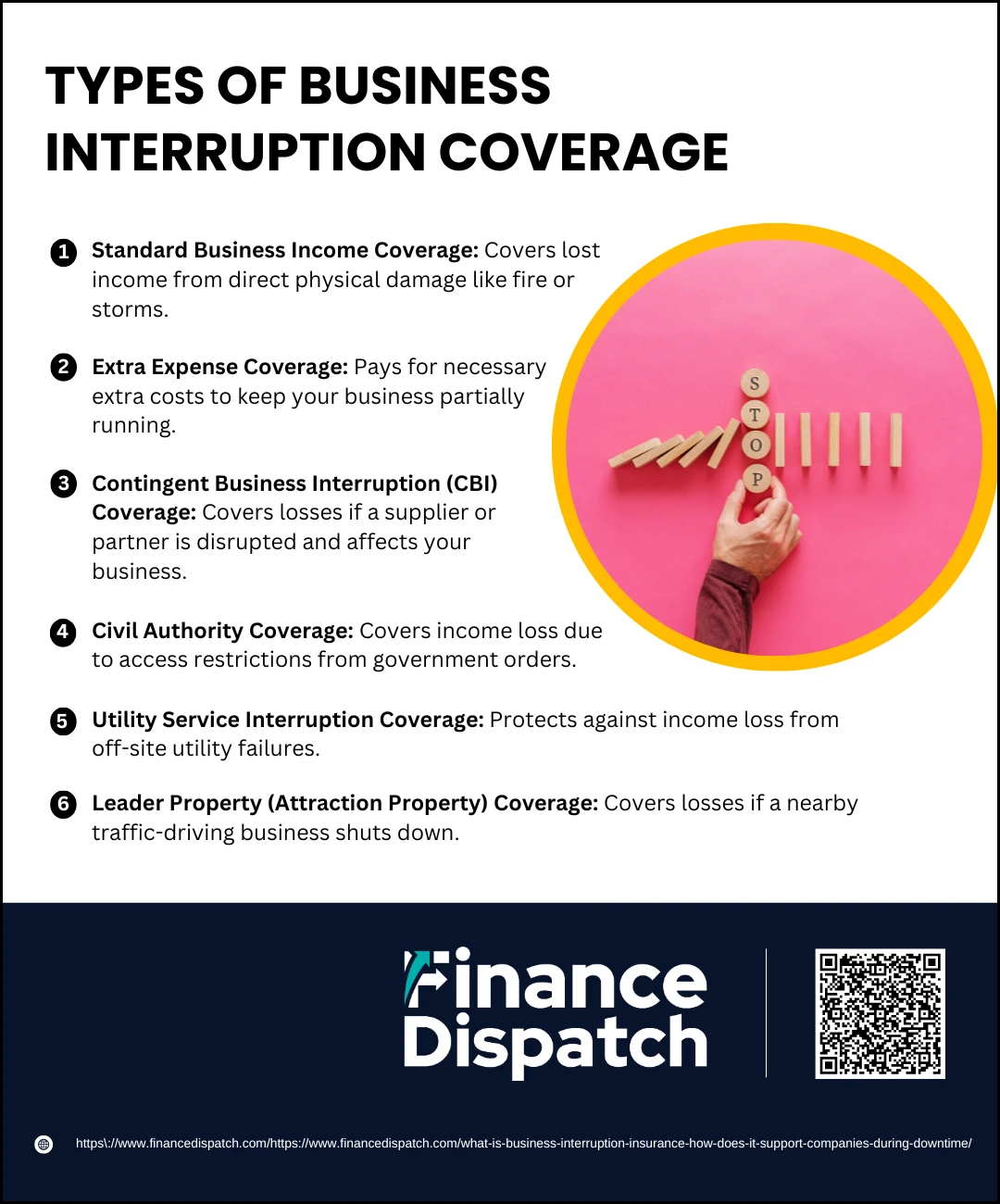 Types of Business Interruption Coverage
Types of Business Interruption Coverage
Business interruption insurance is not limited to one fixed type of protection. It comes in several forms, each addressing a unique scenario that can disrupt your operations. Whether your business suffers a direct hit—like fire damage—or is indirectly affected by a partner’s disruption, different coverage types ensure you have financial support tailored to the situation. Choosing the right mix of coverage is essential for building a resilient risk management plan that helps your business recover faster and stay afloat during uncertain times.
Here are the main types of business interruption coverage explained in more detail:
1. Standard Business Income Coverage
This is the most common form of business interruption insurance. It reimburses you for lost income when a covered event (like a fire, storm, or vandalism) forces your business to shut down temporarily. The compensation is typically based on your historical income records and helps ensure financial continuity while you recover and rebuild.
2. Extra Expense Coverage
Sometimes, a business doesn’t shut down entirely but must take on additional costs to remain partially operational. Extra expense coverage pays for these necessary, out-of-the-ordinary costs—such as renting backup equipment, paying overtime wages, or relocating departments—to keep operations going and reduce the duration of the interruption.
3. Contingent Business Interruption (CBI) Coverage
Your business might not suffer direct damage but could still experience financial loss if a supplier or business partner experiences a disruption. CBI coverage applies in such cases, offering protection if your revenue drops because another business (like a manufacturer or distributor) is impacted by a covered event and can’t deliver what you need.
4. Civil Authority Coverage
If a government order restricts access to your business—such as a forced evacuation, quarantine zone, or road closure near your premises—civil authority coverage steps in. It provides income compensation during the time your business is unable to operate due to these external, mandated restrictions.
5. Utility Service Interruption Coverage
This optional add-on protects against losses caused by off-site utility outages, such as power, water, or internet failures—if the cause is a covered peril. For example, if a storm damages a power station and knocks out your electricity, preventing you from serving customers, this coverage can help replace lost income during the outage.
6. Leader Property (Attraction Property) Coverage
Some businesses depend on neighboring establishments to drive traffic. For instance, a coffee shop located inside a shopping mall may lose customers if the mall shuts down due to damage. Leader property coverage helps in such situations by covering income loss tied to the shutdown of a nearby anchor or high-traffic location.
Cost Factors of Business Interruption Insurance
The cost of business interruption insurance varies based on several key factors unique to each company. One of the biggest influences is the size and type of business—larger operations with higher revenues or more complex operations typically pay more due to the greater potential loss during downtime. Industry also plays a role; businesses in high-risk sectors like manufacturing, hospitality, or retail may face higher premiums due to increased exposure to interruptions. Additionally, the business’s location affects pricing, especially if it’s in an area prone to natural disasters like floods or hurricanes. Other cost factors include the company’s claims history, the length of the desired coverage period (known as the indemnity period), and whether optional endorsements—such as extra expense or utility interruption coverage—are added to the policy. Ultimately, insurers evaluate the likelihood and potential severity of a disruption to determine an appropriate premium, making it essential for business owners to assess their risk profile carefully when choosing coverage.
How to Choose the Right Policy
Choosing the right business interruption insurance policy is critical to ensuring your company can survive and recover from unexpected downtime. Since policies can vary widely in what they cover, how long they provide support, and the types of events they respond to, it’s important to assess your business’s unique risks and financial needs before committing. A carefully selected policy not only protects your income but also strengthens your overall business continuity plan.
Here are key factors to consider when choosing the right business interruption insurance policy:
1. Evaluate Your Business Risks
Consider the specific threats your business faces, such as natural disasters, supply chain vulnerabilities, or reliance on utilities or nearby properties.
2. Estimate Your Income and Fixed Costs
Calculate how much income you need to replace during a closure and identify ongoing expenses—like rent, payroll, and loan payments—that must be covered.
3. Determine the Ideal Indemnity Period
Choose a coverage duration that realistically reflects how long it might take to fully resume normal operations after a major disruption.
4. Understand Policy Exclusions
Carefully review what the policy does not cover—such as floods, pandemics, or undocumented income—and consider whether additional endorsements are needed.
5. Assess Optional Coverages
Consider whether you need add-ons like extra expense coverage, utility service interruption, or contingent business interruption for indirect losses.
6. Review Your Claims History and Financial Records
Insurers may assess your past claims and financial stability. Maintain clean records and strong risk management practices to secure better premiums and terms.
7. Consult an Experienced Insurance Agent or Broker
Work with a professional who understands your industry and can help tailor a policy to fit your specific operational and financial risks.
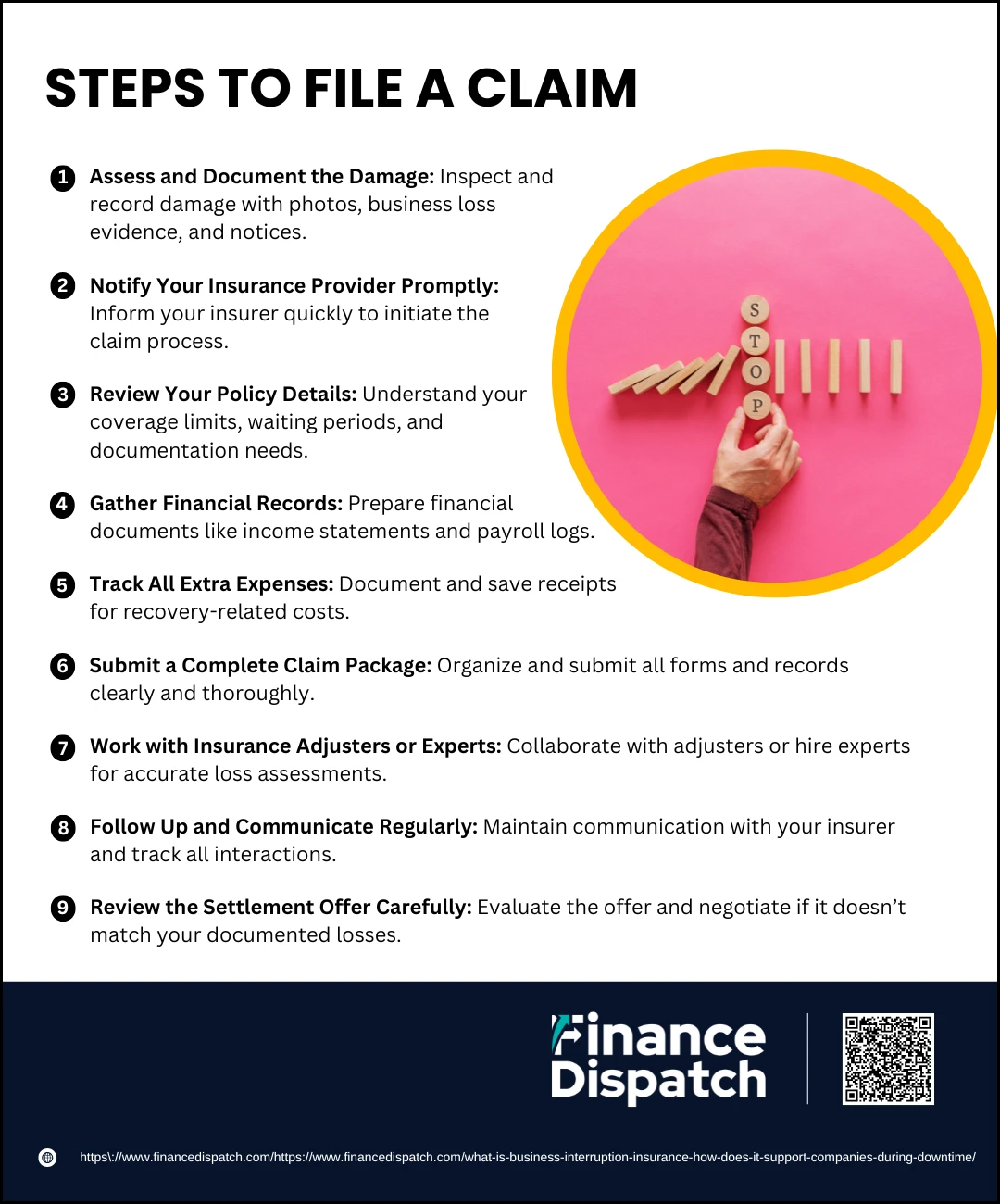 Steps to File a Claim
Steps to File a Claim
Filing a business interruption insurance claim requires more than just notifying your insurer—it demands careful documentation, timely communication, and a clear understanding of your policy terms. After a disruptive event, time is critical. The sooner you begin the claims process, the faster you can secure compensation to stabilize your business and begin recovery. Many claims are delayed or denied simply due to incomplete paperwork or missed deadlines, so knowing what to do ahead of time can make all the difference. Proper preparation and support—such as consulting with experts—can also help maximize your reimbursement and reduce disputes.
Here are the essential steps to file a business interruption insurance claim in more detail:
1. Assess and Document the Damage
Immediately inspect your property and operations to determine the extent of the disruption. Take clear photos or videos of physical damage, document lost business activity (like canceled orders or closed locations), and gather any official notices related to shutdowns (e.g., civil authority orders).
2. Notify Your Insurance Provider Promptly
Most insurance policies have a limited window in which you must report a claim. Notify your agent or insurer right away, even if you’re still assessing the full scope of the loss. Prompt reporting helps establish a timeline and prevents delays in processing.
3. Review Your Policy Details
Carefully read your business interruption policy, including any endorsements or add-ons. Understand what types of losses are covered, the required waiting period before coverage kicks in, and any specific documentation the insurer will expect.
4. Gather Financial Records
Collect and organize detailed financial documents that prove your lost income and continuing expenses. This might include prior income statements, tax returns, payroll logs, rent or lease agreements, and vendor contracts. These records form the basis of your claim.
5. Track All Extra Expenses
If you incur unexpected costs to stay operational—like leasing temporary equipment, relocating to a short-term facility, or paying for expedited repairs—track every dollar spent. Save all receipts, invoices, and time logs to support your claim under extra expense coverage.
6. Submit a Complete Claim Package
Work with your insurer to ensure that all required forms are filled out and that your documentation is submitted in an organized and clear format. Incomplete or disorganized submissions can lead to delays or underpayment.
7. Work with Insurance Adjusters or Experts
The insurer may assign a claims adjuster to review your case. Cooperate fully, but also consider hiring a forensic accountant, public adjuster, or legal expert to help you calculate losses accurately and advocate for a fair settlement—especially for large or complex claims.
8. Follow Up and Communicate Regularly
Keep in touch with your insurance company throughout the process. Respond to their questions or requests for additional documentation as quickly as possible. Keep a record of all communications, including emails, phone calls, and meeting notes.
9. Review the Settlement Offer Carefully
Once the insurer presents a settlement, don’t feel pressured to accept it immediately. Compare it with your documented losses. If the offer seems low or doesn’t match your expectations, you have the right to challenge it through negotiation, mediation, or legal action if necessary.
Real-Life Case Example
When a disruption strikes, business interruption insurance can be the difference between a temporary setback and permanent closure. Real-life examples help illustrate how this type of coverage works in practice and the specific ways it supports companies during critical recovery periods. These cases show that even when disaster hits unexpectedly, the right insurance policy can provide essential financial relief and business continuity.
Here’s a real-life case example that highlights the impact of business interruption insurance:
1. Business Type: Family-owned restaurant
A popular neighborhood restaurant suffered a severe kitchen fire that caused extensive damage and forced it to close for repairs.
2. Cause of Interruption: Fire damage
The fire destroyed key kitchen equipment, damaged part of the dining area, and required a full inspection and rebuild before reopening.
3. Duration of Closure: 8 weeks
During this time, the restaurant could not serve customers or generate any revenue.
4. Business Interruption Coverage Activated:
The restaurant’s business interruption policy included income replacement, extra expense coverage, and civil authority extension.
5. What the Insurance Covered:
- Lost income based on the restaurant’s average monthly sales
- Rent and utility payments during the closure
- Employee wages to retain key kitchen and wait staff
- Temporary marketing to inform customers about the reopening
- Equipment rental for temporary operations (pop-up events)
6. Outcome:
The insurance payout helped the restaurant avoid layoffs, continue paying rent, and reopen with minimal financial strain. Within a few weeks of reopening, customer flow returned to normal, and the business continued to thrive.
Conclusion
Business interruption insurance is more than just a safety net—it’s a crucial part of a company’s risk management strategy. When unexpected events disrupt operations, this coverage provides the financial support needed to sustain income, pay essential expenses, and accelerate recovery. From natural disasters to supply chain failures, businesses face a wide range of threats that can lead to costly downtime. By understanding what’s covered, choosing the right policy, and preparing for the claims process, business owners can ensure they’re not left vulnerable when disaster strikes. In today’s unpredictable world, having business interruption insurance can be the key to surviving setbacks and coming back stronger.



